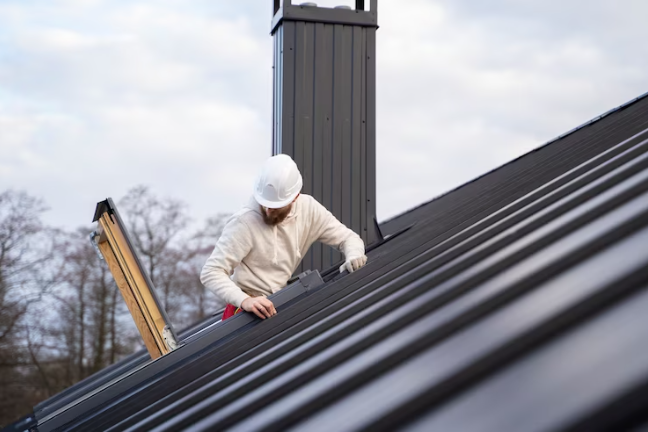Have you ever heard the saying, ‘out of sight, out of mind’? This may be true for many things, but it should never be the case when it comes to your Roofing Problems. Your roof is one of the most important parts of your home, protecting you and your belongings from the elements. However, it is often overlooked until a problem arises.
Understanding and repairing common roofing problems is essential for every homeowner. Whether you are dealing with leaks, damaged shingles, clogged gutters, or improper installation, being knowledgeable about these issues can save you time, money, and frustration.
In this article, we will explore the most common roofing problems and provide solutions for addressing them. By the end of this article, you will be equipped with the knowledge and skills to maintain your roof and prevent future problems from occurring.

Identifying and Fixing Leaks
So, you’ve got a leaky roof? Don’t panic! The first step in identifying and fixing a leak is to locate the source of the problem.
Look for stains or discoloration on your ceiling or walls, as well as any signs of water damage. Check your attic for wet insulation or mold growth. These are all indicators that you have a leak.
Once you’ve located the source of the leak, it’s time to fix it. Repairing flashings is a common solution for leaks. Flashings are strips of metal or other material that are installed around chimneys, vents, and other roof protrusions to prevent water from seeping through.
If your flashings are damaged or improperly installed, they can allow water to enter your home. To repair them, you may need to loosen or remove surrounding shingles, replace the flashing, and then reattach the shingles.
Additionally, waterproofing techniques like applying sealant can help prevent future leaks. With these tips, you can identify and repair leaks in your roof like a pro!
Dealing with Damaged Shingles
If your shingles have been damaged, it’s important to address the issue sooner rather than later to prevent further damage to your roof. Damaged shingles can lead to leaks, and if left unattended, can weaken the structural integrity of your roof.
The first step is to determine whether the shingles need to be replaced or repaired. If the damage is minor, repairing the shingles may be sufficient. This involves carefully removing the damaged shingles and replacing them with new ones. However, if the damage is extensive, it may be more cost-effective to replace the entire roof.
When choosing roofing material, consider the climate in your area and the durability of the material. For example, if you live in an area with harsh winters, a material like metal may be more suitable than asphalt shingles. Ultimately, the best choice will depend on your specific needs and budget.
Clearing Clogged Gutters
You need to clear your clogged gutters to prevent water damage to your home and avoid costly repairs. Gutter maintenance is an essential task that should be done regularly to maintain the longevity of your roof.
When gutters become clogged with debris such as leaves, twigs, and dirt, they can no longer effectively direct water away from your home. This can lead to water damage to your roof, siding, and foundation, resulting in expensive repairs.
To prevent water damage, it’s recommended to clean your gutters twice a year, preferably in the spring and fall. You can use a ladder to access your gutters and remove any debris by hand or with a scoop. It’s also important to check the downspouts for any blockages and ensure that water is flowing freely away from your home.
By maintaining your gutters, you can prevent water damage to your home and save yourself from costly repairs.
Addressing Improper Installation
Improperly installed gutters can cause serious water damage to your home, so it’s crucial to ensure they’re installed correctly. Checking credentials and ensuring warranty are two important steps to take before hiring a professional to install your gutters.
Make sure the contractor you choose is licensed, insured, and has a good reputation in the industry. Request a copy of their insurance certificate and check with your state’s licensing board to ensure they’re authorized to do the work.
When recognizing red flags during the installation process, it’s important to speak up and address any issues immediately. This can prevent further damage and ensure that the job is done correctly.
Some red flags to look out for include improper placement of the gutter system, incorrect alignment, and loose or missing parts. Hiring professionals who have experience in installing gutters can help ensure that the job is done correctly and prevent costly repairs down the line.
By taking the time to properly vet contractors and monitor the installation process, you can help protect your home from water damage and keep your gutters functioning properly for years to come.
Preventing Future Roofing Problems
Preventing future issues with your roof starts with proper maintenance and regular inspections. Regular maintenance is crucial to ensuring that your roof lasts for as long as possible.
This includes cleaning out gutters and downspouts, removing debris from the roof, and checking for any signs of damage. Without proper maintenance, your roof is more likely to experience problems such as leaks, which can lead to expensive repairs.
Another important factor in preventing future roofing problems is weather protection. Your roof is exposed to the elements year-round, so it’s important to take steps to protect it from weather-related damage.
This can include installing proper ventilation to prevent ice dams, ensuring that your roof is properly insulated to prevent heat loss, and making sure that your roof is properly sealed to prevent water infiltration. By taking these steps, you can help to prevent future roofing problems and keep your roof in good condition for years to come.
You’ll need some must-have tools to tackle any fix-it job around the house. Read more!
Frequently Asked Questions
What are the most common causes of roof damage?
To prevent damage to your roof, proper roofing maintenance is essential. The most common causes of roof damage are weather-related. Heavy rain, hail, wind, and snow can all take a toll on your roof over time.
To prevent weather damage, it’s important to inspect your roof regularly and repair any damage as soon as possible. Trimming back overhanging tree branches can also help prevent damage from falling limbs during storms.
Keeping your gutters clean and free of debris is another important preventative measure. Clogged gutters can lead to water damage on your roof.
By taking these measures, you can help extend the life of your roof and avoid costly repairs in the future.
How can I tell if my roof needs to be repaired or replaced?
To determine if your roof needs to be repaired or replaced, start with a thorough roof inspection. Look for signs of damage such as missing or broken shingles, cracked or curled shingles, and dark spots or trails on your roof.
You may also notice leaks in your attic or water stains on your ceilings. If your roof is over 15 years old or has significant damage, it may be time for a replacement. However, if the damage is minor, repairs may suffice.
It’s important to address any issues with your roof promptly to prevent further damage and avoid costly repairs in the future.
Can I fix a leaky roof myself, or do I need to hire a professional?
If you’re dealing with a leaky roof, you may be wondering whether you should try to fix it yourself or hire a professional. While DIY roofing tips can certainly help you tackle some minor issues, it’s important to recognize your limitations.
If you don’t have the experience or tools necessary to properly repair your roof, you could end up causing more harm than good. Additionally, hiring contractors may be a better option if you’re dealing with a larger or more complex issue.
Ultimately, the decision to DIY or hire a professional will depend on your level of expertise and comfort with roofing repairs. Just be sure to weigh your options carefully and prioritize safety above all else.
Are there any preventative measures I can take to avoid roofing problems in the future?
Want to avoid costly roofing problems in the future? Regular maintenance and professional inspections are key.
By taking preventative measures, you can save yourself the headache of dealing with leaks, cracks, and other issues down the line. Don’t wait until it’s too late to take action.
Schedule routine inspections with a trusted professional and make sure to keep up with regular maintenance tasks like cleaning gutters and trimming overhanging branches. Trust us, a little effort now will go a long way in avoiding future roofing headaches.
How much does it typically cost to repair or replace a roof?
When it comes to repairing or replacing your roof, there are several factors that can affect the cost.
Roofing cost factors include the size and pitch of your roof, the materials used, and the extent of the damage or necessary repairs.
DIY roof repair may seem like a cost-effective option, but it’s important to consider the potential risks and safety hazards involved.
If you’re not experienced with roofing, it’s best to leave the repairs to a professional.
While the cost of hiring a professional may be higher, it can save you money in the long run by ensuring that the job is done correctly and preventing further damage to your roof.
Conclusion
Congratulations! You now have a better understanding of common roofing problems and how to fix them.
By identifying and fixing leaks, dealing with damaged shingles, clearing clogged gutters, addressing improper installation, and preventing future roofing problems, you can ensure that your roof stays in top condition for years to come.
Did you know that according to a study by the National Roofing Contractors Association, 70% of all roof failures are caused by improper installation or workmanship? This highlights the importance of hiring a qualified and experienced roofing contractor to ensure that your roof is installed correctly and maintained properly.
Remember, regular maintenance and inspections can help prevent costly repairs and extend the life of your roof. Don’t hesitate to address any roofing problems as soon as they arise, and always prioritize safety when working on your roof.
With these tips and a little bit of effort, you can keep your roof in great shape and protect your home from the elements.

